
This schematic diagram shows how the Universe is thought to have evolved from the Big Bang to the present day. Data from the UKIRT, VLT, and Subaru observatories allowed the astronomers to take four precise and comparable snapshots of the Universe when it was, 2, 4, 6, and 9 billion years old, each containing hundreds of star-forming galaxies. By comparing the different snapshots, astronomers were able to accurately track what has changed over the last 11 billion years. Credit: Chandra / NASA / NOAO / KIPAC
In a new study, an international team of scientists established that the rate of star formation in the Universe is now only 1/30th of what it was at its peak and that this decline will continue.
While parts of the world experience economic hardship, a team of Portuguese, UK, Japanese, Italian and Dutch astronomers has found an even bigger slump happening on a cosmic scale. In the largest ever study of its kind, the international team of astronomers has established that the rate of formation of new stars in the Universe is now only 1/30th of its peak and that this decline is only set to continue. The team, led by David Sobral of the University of Leiden in the Netherlands, publish their results in the journal Monthly Notices of the Royal Astronomical Society.
The accepted model for the evolution of the Universe suggests that stars began to form about 13.4 billion years ago, or around three hundred million years after the Big Bang. Many of these first stars are thought to have been monsters by today’s standards, and were probably hundreds of times more massive than our Sun. Such beasts aged very quickly, exhausted their fuel, and exploded as supernovae within a million years or so. Lower mass stars in contrast have much longer lives and last for billions of years.
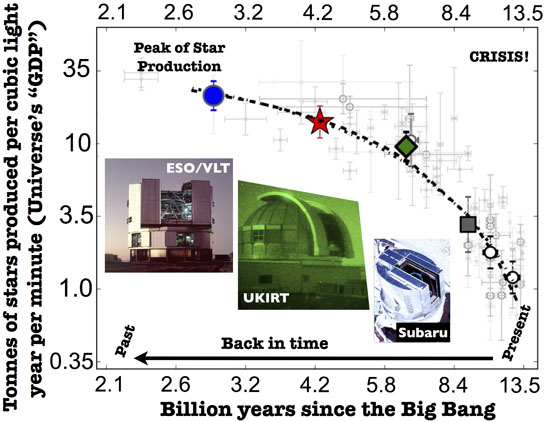
This diagram indicates the changing ‘GDP’ of the Universe over time. The new results indicate that, measured by mass, the production rate of stars has dropped by 97% since its peak 11 billion years ago. Credit: D. Sobral
Much of the dust and gas from stellar explosions was (and is still) recycled to form newer and newer generations of stars. Our Sun, for example, is thought to be a third generation star, and has a very typical mass by today’s standards. But regardless of their mass and properties, stars are key ingredients of galaxies like our own Milky Way. Unveiling the history of star formation across cosmic time is fundamental to understanding how galaxies form and evolve.
In the new study, scientists used the UK Infrared Telescope (UKIRT), the Very Large Telescope (VLT) and the Subaru telescope to carry out the most complete survey ever made of star-forming galaxies at different distances, with around ten times the data of any previous effort. With the range of distances, the time taken for the light to reach us means that we see identically selected galaxies at different periods in the history of the universe, so we can really understand how conditions change over time.
By looking at the light from clouds of gas and dust in these galaxies where stars are forming, the team is able to assess the rate at which stars are being born. They find that the production of stars in the universe as a whole has been continuously declining over the last 11 billion years, being 30 times lower today than at its likely peak, 11 billion years ago.
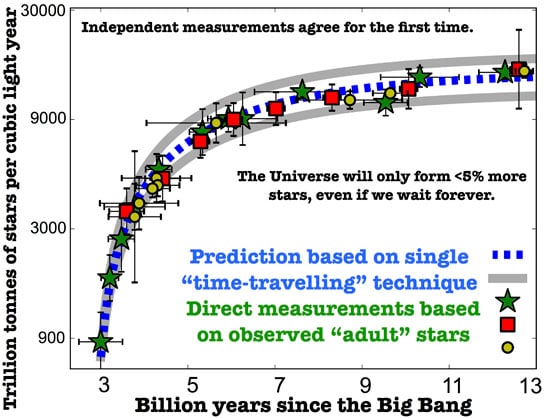
This diagram shows how the total mass of stars in the Universe should have changed over the last 11 billion years based on the new observations (lines) and how it actually did (symbols; different measurements by other teams). This provides an excellent agreement between both and strengthens the prediction of the new results that no more than a further 5% of stars will come into existence, even if we wait forever. Credit: D. Sobral
Dr. Sobral comments: “You might say that the universe has been suffering from a long, serious “crisis”: cosmic GDP output is now only 3% of what it used to be at the peak in star production!”
‘If the measured decline continues, then no more than 5% more stars will form over the remaining history of the cosmos, even if we wait forever. The research suggests that we live in a universe dominated by old stars. Half of these were born in the ‘boom’ that took place between 11 and 9 billion years ago and it took more than five times as long to produce the rest. “The future may seem rather dark, but we’re actually quite lucky to be living in a healthy, star-forming galaxy which is going to be a strong contributor to the new stars that will form.
‘Moreover, while these measurements provide a sharp picture of the decline of star-formation in the Universe, they also provide ideal samples to unveil an even more fundamental mystery which is yet to be solved: why?”
Reference: “A large Hα survey at z = 2.23, 1.47, 0.84 and 0.40: the 11 Gyr evolution of star-forming galaxies from HiZELS” by David Sobral, Ian Smail, Philip N. Best, James E. Geach, Yuichi Matsuda, John P. Stott, Michele Cirasuolo and Jaron Kurk, 7 November 2012, Monthly Notices of the Royal Astronomical Society.
DOI: 10.1093/mnras/sts096



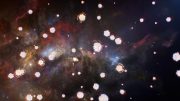


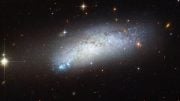

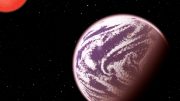
exodus 33:16for wherein shall it be known here that i and thy people have found grace in thy sight?is it not in that thou goest withus?so shall be seperated i thy people;from all the people that are upon the face of the earth:those firstborn over twenty will be die:noel a. glemao#philippines ,palihan,orani,bataan